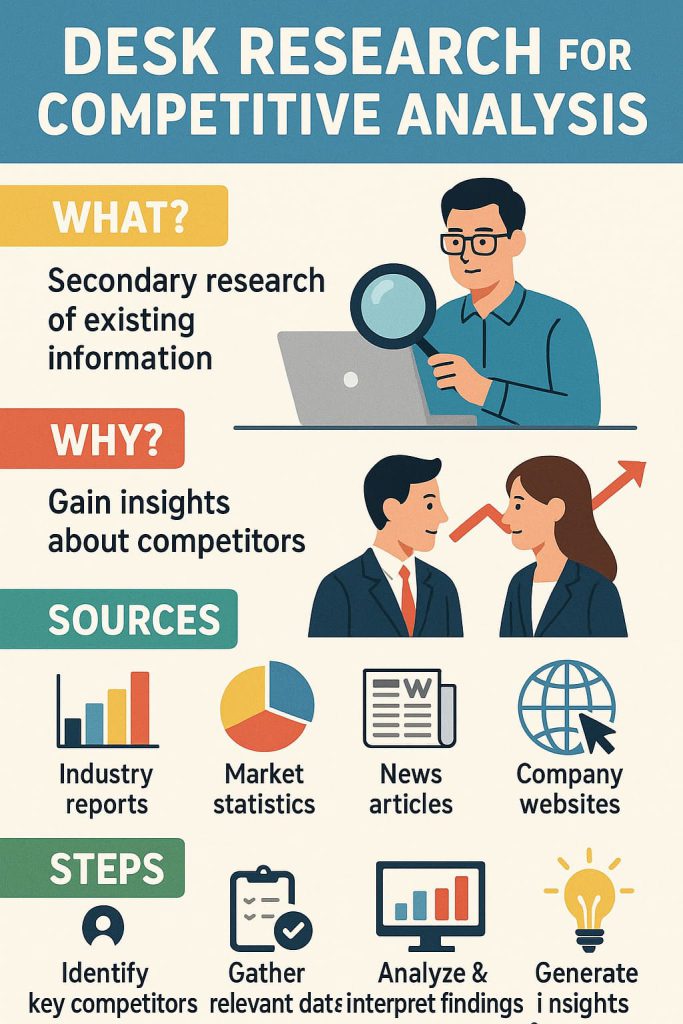Desk Research for Competitive Analysis

Most companies are flying blind when it comes to understanding their competitors. Completely blind. They’re making million-dollar decisions based on gut feelings, outdated information, and whatever their sales team happened to hear from a prospect last week over a lukewarm coffee.
Table of Contents
✅ Listen to this PODCAST EPISODE here:
The Untapped Goldmine of Competitive Intelligence Hiding in Plain Sight
Effective desk research for competitive analysis isn’t about finding some secret document or having insider information—leave that spy novel fantasy behind. It’s about being more systematic, more thorough, and frankly, more obsessive than your competitors about piecing together the puzzle from information hiding in plain sight. It’s about seeing patterns where others see random data points.
The sources? They’re remarkably diverse and embarrassingly underutilized:
- SEC filings and annual reports that most people only skim the executive summary of (the real gold is buried on page 47 in the risk factors section that nobody reads)
- Product documentation that reveals strategic priorities more clearly than any press release
- Patent applications that telegraph future moves months or years in advance (while everyone’s watching product launches that have already happened)
- Career pages and job postings that reveal expansion plans before they’re announced
- Social media footprints that expose targeting strategies to anyone paying attention
- Customer reviews that highlight competitor weaknesses in painful detail
- Pricing pages and wayback machine histories showing positioning shifts that tell you exactly where markets are heading
But here’s the critical point that separates professionals from amateurs: it’s not about accessing these sources—a teenager can do that with a smartphone. It’s about knowing how to extract meaningful patterns from them and connect dots that others miss. It’s about having the mental frameworks to transform random information into strategic intelligence.
The Fatal Flaws in Most Competitive Research Approaches
The problems aren’t complex or mysterious—they’re surprisingly consistent across organizations of all sizes, from tiny startups to bloated enterprises:
Before diving into what works, let’s talk about why most desk research for competitive analysis fails to deliver actionable insights.
- The Random Collection Problem: Information is gathered haphazardly without a structured framework, creating data dumps rather than insights.
- The Outdated Intelligence Issue: Competitive analysis is treated as a one-time project rather than an ongoing process. Markets don’t freeze after you submit your report, but most competitive analysis is instantly fossilized the moment it’s completed.
- The Confirmation Bias Trap: Research is unconsciously filtered to confirm existing beliefs about competitors. “We know Company X is targeting enterprise, so let’s find evidence of that”—while completely missing their massive SMB expansion.
- The Analysis Paralysis Syndrome: So much data is collected that key insights get buried under mountains of irrelevant information.
- The Academic Research Mistake: Reports are comprehensive but fail to highlight actionable implications. “Here’s everything we know about Competitor Y” is dramatically less useful than “Here’s what we should do about Competitor Y.”
What a colossal waste of resources.
The most successful organizations approach desk research for competitive analysis differently. Radically differently. They start with clear questions that need answers, develop systematic collection methods that run continuously rather than sporadically, and create living intelligence assets rather than static reports that are outdated before they’re even circulated.
Mastering the Art of Digital Sleuthing: Advanced Techniques

Beyond the basic framework, there are specialized techniques that separate amateur desk research from professional competitive analysis:
Wayback Machine Analysis: Tracking Positioning Evolution
The Internet Archive’s Wayback Machine is a criminally underutilized tool for competitive analysis. By systematically reviewing how competitor websites have evolved over time, you can:
- Track pricing changes to identify strategy shifts
- Observe messaging evolution to understand positioning changes
- Monitor feature additions and removals
- Identify target market pivots
Financial Forensics: Following the Money Trail
For public companies, financial disclosures offer extraordinary competitive intelligence value beyond top-line numbers:
- Segment reporting reveals prioritization
- R&D spending trends signal future focus areas
- Geographic expansion appears in regional breakdowns
- Customer concentration risks expose dependencies
- Footnotes often contain critical strategic information
Social Listening: Mining Digital Conversations
Beyond basic brand monitoring, advanced social listening techniques can reveal surprising competitive insights:
- Employee sentiment analysis across platforms like Glassdoor, Reddit, and Blind
- Customer conversation mapping to identify emerging pain points
- Tracking share of voice across product feature discussions
- Monitoring response patterns to industry developments
The key is moving beyond simple mention counting to actual conversation analysis. What are people saying about specific aspects of competitor offerings, and how is that changing over time?
Case Study: How Systematic Desk Research for Competitive Analysis Transformed a Market Position

ClearView (not their real name) was getting absolutely crushed by three larger competitors. Their win rate had dropped to 22%. Their deals were taking 40% longer to close. Their pricing was under constant pressure. Morale was tanking. The board was getting restless. Classic David vs. multiple Goliaths scenario.
The CEO had tried everything: product enhancements, pricing changes, sales training, marketing overhauls. Nothing moved the needle significantly. They were on the verge of accepting an acquisition offer at a painful discount when their newly hired Chief Strategy Officer suggested a different approach: implementing systematic desk research for competitive analysis rather than relying on anecdotal competitive information.
The initial reaction? Eye rolls. “We know our competitors already.” “Our sales team tells us what’s happening in the market.” “We don’t have time for academic research projects.”
But with few options left, they gave it a shot. They implemented a structured competitive intelligence program using mostly public information sources analyzed more rigorously than they had previously attempted.
Within 90 days, they had uncovered insights that completely transformed their strategy:
- They identified a pattern of customer complaints across three competitors regarding a specific integration challenge that none were addressing effectively. This wasn’t just one or two complaints—it was a systematic issue appearing in 37% of negative reviews, but no one had quantified it before.
- Through systematic monitoring of job postings, they discovered that two major competitors were actually reducing investment in a particular market segment where they claimed to be focused. The competitors were talking big publicly while quietly shifting resources elsewhere.
- Analysis of pricing page changes revealed that competitors were struggling to monetize a specific feature set—they’d changed pricing models three times in 18 months, a clear sign of uncertainty.
- Systematic review of API documentation exposed fundamental limitations in competitors’ technical architectures that would be extremely costly to overcome.
None of this was secret information. None of it required insider sources or industrial espionage. It was all hiding in plain sight, distributed across dozens of public sources that no one had bothered to systematically analyze before.
With these insights, they completely transformed their approach:
- They refocused product development on the integration gap their competitors were neglecting, making it their central value proposition
- They increased sales resources in the market segment competitors were de-emphasizing, directly targeting accounts the competitors were neglecting
- They developed a pricing model that highlighted competitor vulnerability, making the struggling feature set included rather than premium
- They created marketing messaging that subtly highlighted the technical limitations they’d identified, educating customers to look for issues their competitors couldn’t easily solve
The results weren’t just good. They were transformative. Their win rate against primary competitors increased from 24% to 41% within two quarters. Their average deal size grew by 35% as they focused on the opportunities their research had uncovered. The acquisition offer was rejected, and within 18 months, they were approached by a different acquirer at 3.8x the valuation of the earlier offer.
“What amazes me,” the CEO later commented, “is that all of this information was available to our competitors too. We had no special access. The difference wasn’t what we knew—it was how systematically we gathered and analyzed what was publicly available. We just paid closer attention, for longer, with better methods.”
That’s the essence of effective desk research for competitive analysis. Not secret information. Better processing of available information.

Summary: Desk Research for Competitive Analysis
✅ Begin With Questions: Effective desk research for competitive analysis starts with clear strategic questions rather than information gathering
✅ Implement Systems: Develop systematic monitoring rather than ad-hoc research projects
✅ Focus on Patterns: The greatest insights come from connecting dots across multiple information sources
✅ Create Living Assets: Competitive intelligence should be continuously updated rather than periodic
✅ Drive Action: Research that doesn’t change decisions is merely an academic exercise
✅ Balance Breadth and Depth: Monitor broadly but investigate selectively based on strategic priorities
✅ Verify Through Triangulation: Confirm key insights through multiple sources before acting
✅ Consider Context: Interpret competitor actions within industry trends and market conditions
✅ Leverage Technology: Use specialized tools to enhance research efficiency and effectiveness
✅ Maintain Ethical Standards: Conduct all research legally and ethically to protect organizational reputation
What Makes SIS International a Top Resource of Desk Research for Competitive Analysis
Navigating the complex landscape of desk research for competitive analysis requires specialized expertise beyond basic research skills. Here’s why serious organizations rely on SIS:
- CUSTOMIZED APPROACH: Each competitive research project presents unique requirements based on industry dynamics, competitive landscape, and strategic objectives that generic approaches can’t address effectively.
- THE 40+ YEARS OF EXPERIENCE: Firms with decades of specialized research experience, like SIS 국제 연구, provide methodological expertise and pattern recognition capabilities that dramatically enhance intelligence quality.
- THE GLOBAL DATABASES FOR THE RECRUITMENT: Access to specialized industry databases, proprietary research tools, and historical information repositories enables deeper insight development than publicly available sources alone.
- PROJECTS GET DONE FAST: Professional competitive intelligence teams can deliver actionable insights in days or weeks where internal teams might require months, providing critical time advantages in fast-moving markets.
- AFFORDABLE RESEARCH: Contrary to common assumptions, professional desk research for competitive analysis often costs less than the salary expense of assigning internal teams, particularly when opportunity costs are considered.
- DEEP INDUSTRY EXPERTISE: Understanding the specific competitive dynamics and information landscapes of particular industries dramatically improves research efficiency and insight quality.
- ANALYTICAL RIGOR: Professional researchers apply systematic analytical frameworks rather than ad-hoc approaches, revealing patterns and implications that casual research typically misses.
FAQ: Desk Research for Competitive Analysis
What’s the difference between tactical and strategic competitive intelligence?
Tactical competitive intelligence focuses on immediate, operational questions: competitor pricing, feature comparisons, marketing messaging, and sales tactics. Front-line teams typically use this information to win individual customer opportunities or respond to specific competitive moves. Think of it as intelligence for battles.
Strategic competitive intelligence addresses fundamental questions about market direction, competitor capabilities, emerging threats, and long-term positioning. This intelligence informs major resource allocation decisions, product roadmaps, market entry strategies, and business model evolution. It’s intelligence for winning the war.
The methodologies differ significantly. Tactical intelligence often relies on direct observation, competitor materials, and customer feedback. Strategic intelligence requires deeper pattern recognition across disparate sources, historical analysis, and often subtler signals like talent movement, patent filings, or partnership developments.
How can we ensure desk research avoids legal or ethical issues?
Navigating the ethical and legal boundaries of competitive intelligence is a critical consideration. Professional desk research for competitive analysis maintains clear boundaries:
- Rely exclusively on publicly available information sources
- Never misrepresent your identity or purpose when gathering information
- Respect confidentiality and avoid using information that appears to be leaked inappropriately
- Document information sources to demonstrate proper provenance
- Establish clear organizational policies about acceptable research methods
- Train researchers on legal and ethical boundaries
- Periodically audit research practices to ensure compliance
- Consider creating a competitive intelligence code of ethics
The key distinction is between public information and private information. Public financial filings, published product details, press releases, conference presentations, job postings, and customer reviews are all legitimate sources. Confidential documents, information shared under NDA, or details obtained through misrepresentation are not.
How should competitive intelligence be shared throughout an organization?
This question addresses one of the most common failure points in desk research for competitive analysis: the inability to effectively distribute intelligence to decision-makers.
Effective competitive intelligence distribution requires tailoring both format and content to different stakeholders:
- Executive Leadership: Requires high-level strategic implications, emerging patterns, and market evolution insights, typically in brief, implication-focused formats
- Product Teams: Need detailed feature comparisons, customer feedback analysis, and technology trend information in more comprehensive technical formats
- 영업팀: Benefit from tactical battlecards addressing specific competitive challenges, objection handling guidance, and win/loss analysis in easily accessible formats
- 마케팅: Requires positioning analysis, messaging comparisons, and share-of-voice metrics with creative implications
Beyond tailoring content, effective distribution mechanisms include:
- Regular competitive intelligence briefings for key teams
- Competitive intelligence newsletters highlighting recent developments
- Internal portals or knowledge bases for self-service access
- Competition-focused Slack channels for real-time updates
- Quarterly deep-dive sessions on strategic competitive developments
How can start-ups conduct effective competitive research with limited resources?
Startups can implement remarkably effective approaches by:
- Focusing narrowly: Stop trying to monitor everything. That’s amateur hour. Identify the 2-3 most critical competitive questions that would actually change your strategy and focus exclusively on those. Better to be deep on what matters than shallow on everything.
- Leveraging free tools: You don’t need a six-figure software budget. Utilize Google Alerts (still criminally underused), social listening tools like Hootsuite’s free tier, and free versions of research tools like BuiltWith for basic monitoring.
- Creating research routines: Discipline beats resources every time. Establish weekly routines for checking specific competitor resources (pricing pages, product updates, job postings) and stick to them religiously. Thirty minutes every Monday morning can yield more insights than sporadic deep dives.
- Distributing the workload: Assign different team members to track specific competitors or information types based on their normal responsibilities. Your customer success people should track competitor product reviews. Your developers should monitor technical documentation. Your salespeople should collect competitive intelligence from prospects.
- Utilizing browser extensions: Tools like Distill.io can automatically monitor web pages for changes, alerting you when a competitor changes pricing, updates their feature list, or posts new jobs. Set it up once, get alerts forever.
- Developing expert networks: Build relationships with industry analysts, journalists, and thought leaders who track your market. They often have broader perspectives than any single company and can provide context you might miss.
- Monitoring investor information: For competitors with venture funding, Crunchbase and funding announcements provide strategic insights into where they’re heading. What investors say about their portfolio companies often reveals more than official press releases.
- Analyzing customer interactions: Systematically debrief after competitive sales situations. Why did you win? Why did you lose? What feature comparisons came up? This frontline intelligence is gold that most companies never mine effectively.
How do you measure the ROI of competitive intelligence activities?
Measuring the return on investment for desk research for competitive analysis challenges many organizations, particularly because the benefits often appear indirectly through better decision-making.
Effective measurement approaches include:
- Win/loss improvement: Tracking changes in competitive win rates following intelligence implementation
- Decision impact assessment: Documenting specific decisions influenced by competitive insights
- Surprise reduction: Measuring how frequently the organization is surprised by competitor moves
- Time compression: Assessing how quickly the organization identifies and responds to competitive changes
- 전략적 정렬: Evaluating how competitive intelligence has improved strategic clarity
- Opportunity identification: Tracking new opportunities identified through competitive analysis
How do you separate signal from noise in competitive research?
In an age of information overload, distinguishing meaningful competitive signals from background noise represents perhaps the greatest challenge in desk research for competitive analysis.
Effective practitioners use several approaches:
- Pattern recognition: Looking for the same signal across multiple sources rather than reacting to isolated data points
- Strategic filtering: Evaluating all information against key strategic questions rather than collecting everything
- Historical contextualization: Assessing new information against historical patterns rather than in isolation
- Cross-functional validation: Checking insights with multiple internal experts to identify false signals
- Confidence weighting: Assigning confidence levels to intelligence rather than treating all information equally
- Significance testing: Asking “what decision would this information change?” to assess actual importance
뉴욕에 있는 우리 시설 위치
11 E 22nd Street, Floor 2, New York, NY 10010 전화: +1(212) 505-6805
SIS 인터내셔널 소개
SIS 국제 정량적, 정성적, 전략 연구를 제공합니다. 우리는 의사결정을 위한 데이터, 도구, 전략, 보고서 및 통찰력을 제공합니다. 또한 인터뷰, 설문 조사, 포커스 그룹, 기타 시장 조사 방법 및 접근 방식을 수행합니다. 문의하기 다음 시장 조사 프로젝트를 위해.


